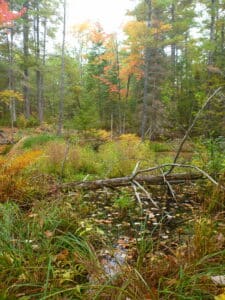Why we need a glyphosate ban in forestry
Article on Glyphosate in Canada written by Dr. Ole Hendrickson, Conservation Chair, Sierra Club Canada Foundation. Originally posted on August 13th, 2021.

Photo by / par Ole Hendrickson.
Shotgun, Flame, Renegade, Destroyer, Disruptor, Mad Dog: Does this sound like the basis of a respectful relationship between humans and the natural environment?
These are just a few of the glyphosate herbicide products currently registered for use in forests by Canada’s Pest Management Regulatory Agency (PMRA).
Commercial use of glyphosate in forestry began in 1976 when Monsanto registered this chemical under the trade name Roundup. A February 1978 study by Roy Sutton of the Canadian Forest Service said: “Environmentally safe, yet potent in controlling herbs, grasses, and woody species, with possibilities for selective use, glyphosate has great potential usefulness in forestry.”
Find out more about our work to protect natural spaces from substances like Glyphosate in Canada
- Take action to protect nature.
- Sign up for email updates on our homepage.
- Sierra Club Canada’s work to protect biodiversity, nature, and endangered species.
But the White Spruce seedlings in Sutton’s study showed large decreases in survival — “a gradual dying off of trees under severe and sustained stress.” In a 1984 paper he warned that “Success in controlling non-crop vegetation does not necessarily mean that crop trees will subsequently perform well.”
In Finding the Mother Tree, UBC forestry professor Suzanne Simard recounts her decades-long effort to persuade her former BC Forest colleagues to take an evidence-based approach to forest herbicide use. But her colleagues clung to their simple-minded view of “kill the competition”.
Simard’s ground-breaking 1997 paper showed that different tree species cooperate by shuttling carbon back and forth through underground fungal networks. Douglas-fir — a desired conifer species — was benefiting from a net transfer of carbon from White Birch, then considered an unwanted competitor.
But a quarter century later, BC and Ontario still allow glyphosate spraying. Even with forest fires raging, releasing immense amounts of carbon and destroying communities, spraying of herbicides remains standard practice in most jurisdictions. Indigenous peoples decry this “rain of death”, which creates a hot and dry landscape devoid of wildlife and prone to burning.
Health consequences of glyphosate use may not be limited to deaths associated with heat waves, fires, and deteriorating air quality. Although the 2015 finding of the International Agency for Research on Cancer that glyphosate is a probable human carcinogen is controversial, recent evidence supports this, particularly for non-Hodgkin lymphoma.
Monsanto will forever be synonymous with Roundup and glyphosate, but Bayer purchased Monsanto in 2018. Bayer now sells 22 of the 105 glyphosate products registered by PMRA for forest use. Other chemical companies in the game include FMC, Nufarm, Corteva, Albaugh and Teragro.
Glyphosate is also Canada ’s major agricultural pesticide. Many farmers spray their crops just before harvest to kill and dry them out quickly, leaving high glyphosate residues in the food we eat. In May 2021 PMRA proposed a 2- to 4-fold increase in maximum glyphosate residues to enable this practice. Push-back was intense. Organic farmers warned of unintentional contamination of their products. On August 4th the government paused a decision on the PMRA proposal until spring 2022.
PMRA is notorious for non-transparent, industry-friendly decisions on pesticides. Independent observers see some hope in that the government’s pause also includes a new expert panel process to advise PMRA on pesticides, and $42 million to improve data availability for pesticide reviews.
PMRA could ban glyphosate in forestry, or ban all uses. On April 15th former Green Party (now Liberal) MP Jenica Atwin introduced Private Member’s Bill C-285, calling for a complete ban. Provinces could act independently of the federal government. Quebec stopped using herbicides in forestry 20 years ago.
Prospects for federal action are uncertain. Agriculture Minister Marie-Claude Bibeau and Health Minister Patty Hajdu (responsible for PMRA) are currently the most heavily lobbied federal ministers.
But one thing is certain. Continued use of glyphosate in forestry will worsen the effects of climate change and destroy prospects for humans and other species to enjoy a healthy future.
